Tiruvarur, Tyagaraja Temple
Historical background
Tiruvarur, in the heart of the Kaveri Delta, some 53 km east of Thanjavur, is renowned for the Tyagaraja temple, one of the most important Shaiva sacred sites of southern India. This large temple complex enshrines twin sanctuaries, the first dedicated to Tyagaraja, the form of Shiva together with his consort Uma and their son, Skanda-Murugan, sited immediately to the south of the second, the foundational shrine, dedicated to Valmikinatha i.e.Shiva as the Lord of the Anthill. Both shrines date back to the 11th century and were among those especially honoured by the Cholas. Later additions to the complex date of the Vijayanagara, Nayaka, and Maratha rule.
Read more
Of particular interest are the 17th century ceiling and wall paintings in the Devasiriya mandapa, illustrating important legends connected with this site. One, on the north wall, summarises the complex foundational myth of the temple by simply showing an anthill, where Shiva, as Valmikinatha has taken residence.
Immediately near it, is the story of the Chola king Manuniti, ‘establisher of Manu’s justice’, a devotee of Shiva. According to the legend, he did not hesitate to run over his own son, whose chariot had run over and killed a calf. Shiva, moved by the king’s sense of justice, appeared before him and revived the prince and the calf.
The third narrative, laid out on the ceiling, is that of yet another devotee of Shiva, the monkey-faced Chola king, Muchukunda. In a former life Muchukunda was a great devotee of Shiva. The god, pleased with his piety, blessed him to be born as a Chola king. Muchukunda, renowned for his valour, was instrumental in helping Indra to win the battles against the asuras. As a reward Indra gave him the image of Tyagaraja. On returning from Indra’s heaven, Muchukunda installed the image at Tiruvarur, at the side of that of Valmikinatha.
Besides the Muchukunda story, the murals on the ceiling depict in great detail the Panguni Uttiram and the Vasantotsava festivals. Twice a year the deity’s festival image, Chandrashekhara, is taken from its sanctuary to the Devasiriya mandapa in the outer precinct of the temple. During the Panguni Uttiram festival, in March-April, the image leaves the temple and is paraded on various vahanas through the streets skirting it. In April-May at the climax of the Vasantotsava (Spring festival) celebrations Chandrashekhara rides through the street on an impressive ceremonial chariot.
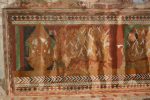
Date: 17th century
Description: Indra briefs his messenger and sends an embassy to Muchukunda; Valasura assembles his army.
Location: Tamil Nadu Temple;Tyagaraja Temple;Tiruvarur
Positioning: Devasiriya mandapa, ceiling, first bay from the south
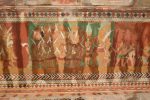
Date: 17th century
Description: Valasura imparts orders to his troops.
Location: Tamil NaduTemple;Tyagaraja Temple;Tiruvarur
Positioning: Devasiriya mandapa, ceiling, first bay from the south
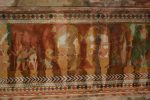
Date: 17th century
Description: Valasura on his chariot (left) and Valasura on his chariot in battle (right).
Location: Tamil Nadu Temple;Tyagaraja Temple;Tiruvarur
Positioning: Devasiriya mandapa, ceiling, first bay from the south
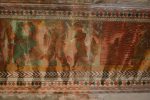
Date: 17th century
Description: Valasura and his troops confront a volley of arrows from Indra’s army.
Location: Tamil NaduTemple;Tyagaraja Temple;Tiruvarur
Positioning: Devasiriya mandapa, ceiling first bay from the south
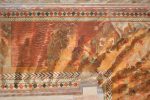
Date: 17th century
Description: Indra on a chariot and his troops fight against Valasura’s army.
Location: Tamil Nadu Temple;Tyagaraja Temple;Tiruvarur
Positioning: Devasiriya mandapa, ceiling, first bay from the south; east corner
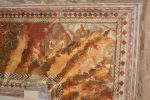
Date: 17th century
Description: Indra on a chariot and his troops fight against Valasura’s army.
Location: Tamil Nadu Temple;Tyagaraja Temple;Tiruvarur
Positioning: Devasiriya mandapa, ceiling, first bay from the south; east corner
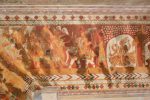
Date: 17th century
Description: Indra fights Valasura; Indra on foot (right) and Indra on the elephant Airavata, and his troops (left).
Location: Tamil Nadu Temple;Tyagaraja Temple;Tiruvarur
Positioning: Devasiriya mandapa, ceiling, first bay from the east
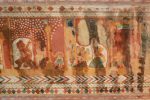
Date: 17th century
Description: Music and dance in Amaravati, Indra’s heaven; News of Valasura’s attack arrive.
Location: Tamil Nadu Temple;Tyagaraja Temple;Tiruvarur
Positioning: Devasiriya mandapa, ceiling, first bay from the east
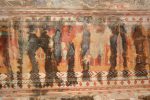
Date: 17th century
Description: Scenes in Amaravati, Indra’s heaven. On the extreme right, the image of Tyagaraja.
Location: Tamil Nadu Temple;Tyagaraja Temple;Tiruvarur
Positioning: Devasiriya mandapa, ceiling, first bay from the east
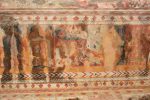
Date: 17th century
Description: Indra installs the image of Tyagaraja in his shrine and worships the deity.
Location: Tamil NaduTemple;Tiruvarur
Positioning: Devasiriya mandapa, ceiling, first bay from the east
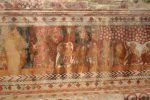
Date: 17th century
Description: Tyagaraja in procession in Indra’s heaven, Amaravati; Musicians and dancers.
Location: Tamil Nadu Temple;Tyagaraja Temple;Tiruvarur
Positioning: Devasiriya mandapa, ceiling, first bay from the east
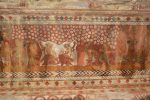
Date: 17th century
Description: The apsaras welcome Tyagaraja in Amaravati, Indra’s heaven.
Location: Tamil NaduTemple;Tyagaraja Temple;Tiruvarur
Positioning: Devasiriya mandapa, ceiling, first bay from the east
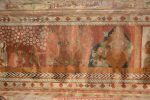
Date: 17th century
Description: The icon of Tyagaraja, placed on a chariot, and escorted by the gods arrives in Indra’s heaven, Amaravati. The apsaras dance to welcome his arrival.
Location: Tamil Nadu Temple;Tyagaraja Temple;Tiruvarur
Positioning: Devasiriya mandapa, ceiling, first bay from the east
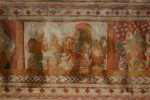
Date: 17th century
Description: Vishnu seated on the coils of the serpent Shesha and flanked by Garuda, hands over to Indra the Tyagaraja icon. Indra prostrates before Tyagaraja and takes the image to Amaravati.
Location: Tamil Nadu Temple;Tyagaraja Temple;Tiruvarur
Positioning: Devasiriya mandapa, ceiling, first bay from the east
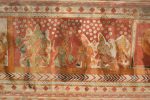
Date: 17th century
Description: Indra prostrates before Vishnu flanked by Garuda; Vishnu, on Garuda’s shoulders flies back to the Ocean of Milk; Indra follows him there.
Location: Tamil Nadu Temple;Tyagaraja Temple;Tiruvarur
Positioning: Devasiriya mandapa, ceiling, first bay from the east
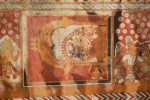
Date: 17th century
Description: Indra returns to Chidambaram where he performs penance, requesting that the Tyagaraja image may be transferred to his abode, Amaravati.
Location: Tamil Nadu Temple;Tyagaraja Temple;Tiruvarur
Positioning: Devasiriya mandapa, ceiling, first bay from the east
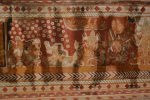
Date: 17th century
Description: Celebrations of Vishnu’s victory over Varkali; the gandharvas shower flowers; music and dance in the world of the gods, Devaloka.
Location: Tamil Nadu Temple;Tyagaraja Temple;Tiruvarur
Positioning: Devasiriya mandapa, ceiling, first bay from the east
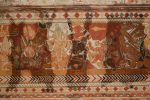
Date: 17th century
Description: Vishnu, on Garuda’s shoulders arrives on the battlefield. He destroys Varkali’s chariot; Varkali flees and beheaded by the god’s chakra, falls at his feet.
Location: Tamil Nadu Temple;Tyagaraja Temple;Tiruvarur
Positioning: Devasiriya mandapa, ceiling, first bay from the east
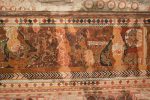
Date: 17th century
Description: On the right: The gods see Vishnu on Garuda descend on the battlefield; Vishnu on his chariot attacks Varkali.
Location: Tamil Nadu Temple;Tyagaraja Temple;Tiruvarur
Positioning: Devasiriya mandapa, ceiling, first bay from the east
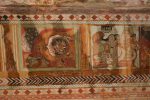
Date: 17th century
Description: Indra informs Vishnu of his defeat by Varkali. Vishnu sends him to Chidambaram to worship Nataraja. On the right, Indra approaches Vishnu reclining on the serpent Shesha floating on the Ocean of Milk; On the left; Indra worships Nataraja and Shivakami enshrined at Chidambaram. Bottom left; The image of Vishnu reclining on Shesha in the Govindaraja temple at Chidambaram
Location: Tamil Nadu Temple;Tyagaraja Temple;Tiruvarur
Positioning: Devasiriya mandapa, ceiling, first bay from the east
1 2 3 … 5 Next »